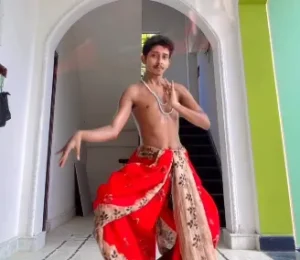In a small town in West Bengal, where evenings meant boys playing cricket under dusty yellow streetlights, Somnath Das grew up learning one lesson early: boys don’t dance. It wasn’t a rule written anywhere, but it was spoken in the way people stared, whispered, and laughed. Cricket was the only acceptable dream; everything else was just a distraction.
Somnath was different—and he knew it long before anyone told him so
Music did something to him. When a song played on TV, his feet moved before he could stop them. When classical tunes floated from neighbours’ radios, his hands followed the melody in the air. And every time he danced, just for a second, he felt like he belonged somewhere.
But the world was quick to remind him that he didn’t
“Too girly.”
“Dance is not for boys.”
“Learn cricket instead.”
Children repeated what they heard at home. Adults repeated what they believed. And a young Somnath learned to hide the most honest part of himself. He danced only behind locked doors, in the dim corner of his room, silently praying no sound would give him away. He became an expert at shrinking—at folding parts of himself so small that no one could find them.

Then came 2018
One ordinary afternoon, Somnath watched Nora Fatehi perform Dilbar for the first time. That performance wasn’t just a dance—it was a storm. Her grace, her strength, her unapologetic confidence, everything about her shook him awake. For the first time, he saw someone move in a way that felt like the language of his own heart.
He replayed the video again and again until he knew every beat, every roll, every breath.
That night, he stood in front of his mirror, took a deep breath, and let his body move. It wasn’t perfect. It wasn’t polished. But it was his. And for the first time in years, he didn’t feel wrong. He felt free.
That moment of freedom pushed him to do something unimaginable—he recorded a short belly dance clip and posted it online.
What followed changed his life overnight
Notifications exploded. His phone buzzed relentlessly. One video—just one—went viral. People praised him:
“So graceful!”
“So confident!”
“This is talent!”


But with the applause came a darkness he wasn’t prepared for
Trolls attacked him. Strangers mocked him. People questioned his identity, his masculinity, his character—all because he dared to dance differently.
For a day, Somnath wanted to delete everything and disappear.
But then a message arrived.
A young girl wrote, “Bhaiya, will you teach me to dance like you?”
Another said, “You made me feel brave.”
And a little boy commented, “I want to dance too… but I’m scared.”
Something shifted inside Somnath that day. The world was divided—some clapped, some cursed—but the ones who needed him the most were watching quietly, finding courage in his courage. He couldn’t walk away now.
So he kept dancing.
Kept uploading.
Kept teaching kids who arrived with shy smiles and big dreams.
Some nights he practiced until midnight, repeating one movement until sweat dripped down his back and the world outside grew silent. Those late-night sessions became therapy—his way of healing the wounds society had given him.



